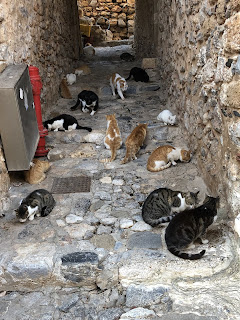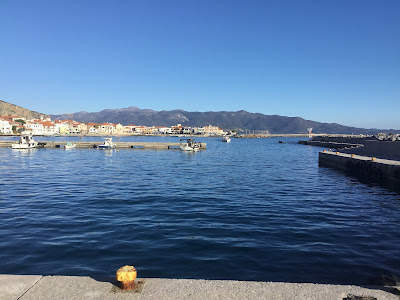Greece has some of the world’s finest historic sites, stretching back through antiquity. However, as we found when we visited Ancient Messina, the authorities are remarkably relaxed about letting visitors have access to them. So, where in the UK you might find barriers and notices warning you to keep off, the same does not apply in most of Greece. We therefore found ourselves standing among a number of ancient graves which had been carved out of the rock close to the sea near Neapoli with not a thing to stop us wandering all over the area.
We had walked to the site along what was probably the longest beach we had seen so far in Greece....and it was completely deserted. We discovered it was also one of the main nesting grounds of loggerhead turtles although, regrettably, we were too early in the year to see them. Our wander had been enlivened, although not in a particularly good way, by Max’s decision to set off again on one of his marathon swims. Thus it was we spent a great deal of the outward walk anxiously watching the head of a spaniel bobbing in the waves at least 50m from the shore. He is a strong swimmer but his tendency to completely ignore our calls for him to come back in are frustrating to say the least. He did eventually return, and spent the rest of the walk on a lead.
 |
| The longest beach so far |
 |
| The dead are long gone |
It was destroyed by an earthquake around 1000 BC, an event that also severed the island from the coast. Through the clear sea water it is possible to see some of the remains of the settlement. On the rocks where we were standing were graves, dating back even earlier to the Bronze Age. Apart from a simple sign saying ‘Prehistoric Cemetery’ there was nothing else to identify this amazing area.
 |
| What’s left of a Byzantine church |
Having gazed down at the roofs of the houses below, and across the sparkling deep blue Aegean, we decided to pop into a restaurant in the new town (a mere thousand years old) where the friendly owner served us with a wonderful mezze and lovely local wine. We took the remains of the carafe out onto the terrace where we were joined by five local cats
 |
| Cats seem to run Monevasia |
 |
| The top of the rock |
 |
| The roofs of the new town |
 |
| The church on the rock |
 |
| We have had some lovely sunsets |
 |
| There can be few more beautiful places to be buried |
 |
| Spaniels seem to like beaches |



What a sky.
ReplyDeleteIsn’t it? 😁
Delete